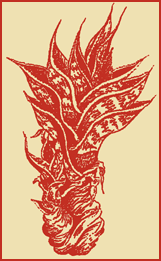Kanniedood - Aloe variegata

Aloe variegata also known as kanniedood
Aloe variegata, also known as kanniedood (in Afrikaans), is among the most well-known of South Africa's aloes, and is also one of the most special. It is endemic to the semi-arid and arid regions of South Africa and southern Namibia. Its was first described in the journal of Simon van der Stel after he saw a sample in Namaqualand on 16 October 1685.
It is the official emblem of the Griqua [Gri-Nation] the last surviving Khoekhoe polity... chosen because the word kanniedood (literally, cannot die) symbolises their endurance and ability to survive adversity. It is also a symbol of fertility and of eternal life.
The image of the kanniedood used in Uprooted Lives (in the articles and on the website) was drawn for Mansell Upham by Belinda Burchell (coloured by Delia Robertson) from a live plant given to him by then Griqua paramount Chief AAS le Fleur II in recognition of Mansell's work as legal representative of the Griqua both locally and internationally.
Mansell chose this image because of the kanniedood's "indigeneity and its connections to the indigenous people of the Cape of Good Hope and my association with this people in terms of ancestry, heritage, research; and also national and international legal representation." Also, he says, for its "obvious survival qualities..." and because it is "a potent symbol of a continuing indigenousness throughout Southern Africa - and hopefully my own, too!"